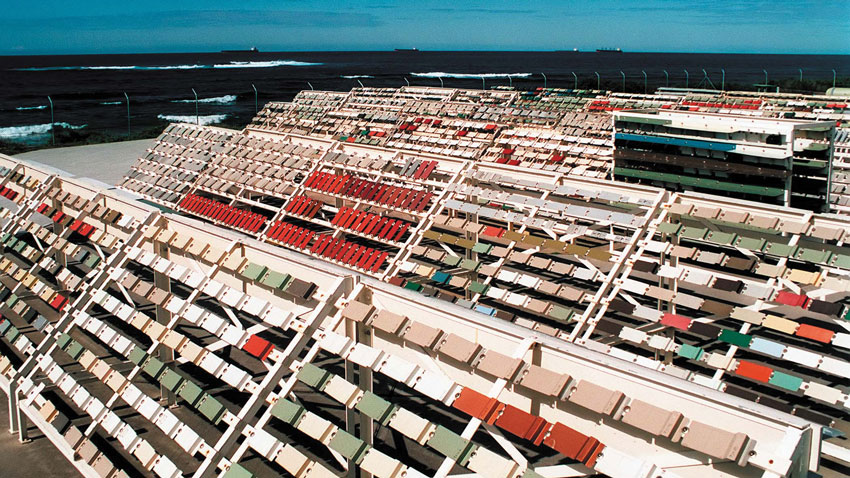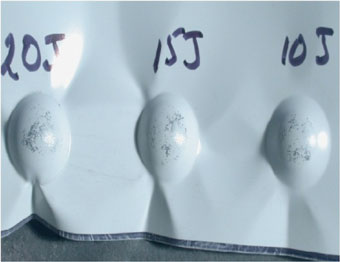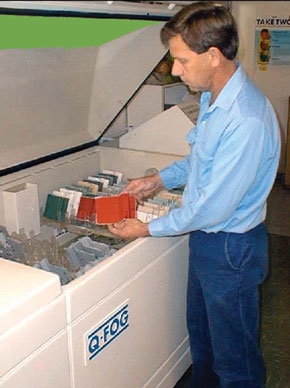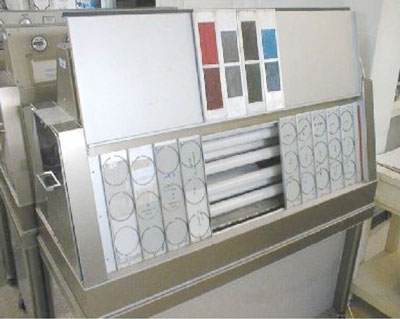
There are different assessment options available for performance evaluation of coated steel. This article will give some inside to readers on important performance evaluation options related to physical testing, corrosion and paint durability of coated steel.
Options For Testing Coated Steel

Physical Testing - This type of testing is the quickest and usually without any chemical reaction.
Accelerated Testing - Accelerated testing is simulated / aided testing involving chemical/physical changes over a short period of time. This helps in assessing performance over a long period of usage. While these tests are quick, they do not represent actual conditions. Accelerated tests are quick but not quick enough for batch-wise testing and immediate certification post manufacturing. In short, these tests are difficult to perform batch-wise for inclusion of results in Mill Test Certificate.
Outdoor Exposure - Coated steel products are for a long period of usage. Therefore, determining life expectancy of these products is important. While accelerated lab tests give quick assessment of the product performance, they do not account for the difference in actual conditions at usage sites. The differences at these sites occur due to -
- Macro and micro factors associated with geographical location
- Change in working conditions over a period of time
- Unusual local environment conditions that these products are subjected to at different times during life cycle
Under the three afore-mentioned testing options, various assessments are available for different performance parameters. More tests are carried out on painted steel as opposed to metallic coated steel. Test procedures and assessment criteria for these tests may differ from one standard to other. One needs to follow the specific one.
Performance Parameters
Physical Testing per say is typically without any exposure and conducted in a laboratory. However, the test samples exposed for accelerated testing or outdoor testing require further assessment/ physical testing in laboratory for different performance parameters.Examples of Performance Parameters under physical testing are
- Strip Thickness & Width Measurement
- Flatness (Steepness Ratio) and Shape Parameters (Coil Set & Cross Bow)
- Ultimate Tensile Strength, Yield Stress, % Elongation (Tensile Test)
- Adhesion- Reverse Impact Test
- T-Bend Adhesion/Flexibility
- Paint Film Adhesion- Cross Hatch
- Machine Colour Assessment
- Visual Colour Assessment
- Gloss
- Paint Film Thickness
- Paint Constituents
- Paint Film Hardness- Pencil Hardness Test
- Resistance to Abrasion
- Resistance to Solvent
- Metallic Coating Mass, etc.
- Metallic Coating Mass Loss
- Degree of Color Change
- Resistance to Chalking
- Resistance to Corrosion (Rust, Blistering, Undercutting, Loss of Adhesion)
- Resistance to Humidity (Blistering, Loss of Adhesion), etc.
Physical Testing Assessments
Tensile TestUnder this, the test piece is stretched in a load frame until the piece breaks. The Ultimate tensile strength, yield stress and % elongation are measured to confirm that the product complies with the appropriate standard of strength and ductility. This property is primarily of base steel and the test helps to determine whether the steel has been thermo-mechanically treated correctly and is fit for use. It is important to note that for calculation purposes "base steel thickness" should be considered and not "coated thickness".
Reverse Impact Paint Adhesion

Adhesion of Metallic Coating
Adhesion to base steel is checked for peels off on bend to ensure that the metallic coating has bonded well with steel base. Peeling of the coating is an indication of poor metal coating line furnace conditions or dirty/rusty steel feed.T - Bend Paint Adhesion and Flexibility
This test determines the paint cracking and pick off on bending. After a sample has undergone a 180° bend (0T), adhesive tape is applied to the bend and ripped off for determination. Bend is repeated (but with larger radius of curvature to 1 sample thickness inside i.e.1T), and continued to higher bend radius until there is no paint removal or cracking.Machine Colour Variation
The colour machine compares the colour with that of the standard. This gives a value indicating how different the color is to the standard. Variation of colour could be due to dry film thickness variation / paint not cured correctly / paint not stirred correctly.Visual Colour Variation
The colour sample is placed next to the standard, inside a light box. The person testing it then determines if there is a noticeable colour difference. If there is a noticeable difference, the sample is moved a set distance away from the standard until no difference is noticeable. Visual colour testing is considered more important than machine colour testing. Achieved rating is determined as per the table on next page.Rating Description
- Exact match, no difference in colour detectable with sample edge in contact with edge of standard
- Critical Match, no difference in colour detectable with sample 5 mm from standard
- Close Match, no difference in colour detectable with sample 20 mm from standard
- Approximate Match, no difference in colour detectable with sample 100 mm from standard
- Poor Match, a colour difference is still detectable when sample and standard are spaced 100 mm apart
Gloss
Gloss or Specular Gloss is luminous fractional reflectance in the specular direction from a painted surface. The gloss meter uses light waves and reflection to determine gloss rating. Gloss is generally tested using the 60° geometry. If the gloss is higher than 70 unit, the 20° geometry is to be used. If the 60° gloss is below 10 unit, the 85° geometry may be used. Higher gloss than expected can indicate topcoat undercured / primer overcured. Lower gloss than expected can indicate topcoat overcured / primer undercured.Dry Film Thickness (DFT)
For determination of DFT of painted steel, a 1 mm diameter hole is drilled in sample through the substrate. Measurements can be made of primer, paint and total dry film thickness. Low dry film thickness could cause early delamination and high dry film thickness could cause edge beading or frosting. Variations in dry film thickness can vary the visual colour.Fourier Transform Infrared Spectroscopy (FTIR)
A small scraping of the paint is taken from the sample and exposed to identify primers and resins in the paint.X-Ray Diffraction (XRD)
X-Ray Diffraction is a qualitative assessment used for pigment analysis of paints and corrosion identification. It can identify heavy metal pigments (e.g. Lead) used in paints.Pencil/Paint Hardness
The purpose of this test is to check the hardness of paint coating. Different hardness pencil leads are pushed along the surface of the sample. The hardest lead pencil which does not penetrate the coating determines the degree of paint film hardness. The hardness of the paint, which is a characteristic of that paint film, can be an indication of the scratch resistance of the paint film. Lower than expected pencil hardness can indicate the paint is under cured.Abrasion Resistance
The test is important for applications where a product is subject to regular abrasion. For this test, abrasive wheels are used on the surface. The measurement is - weight loss over specified nos. of cycles.Double Rub Solvent Resistance
The test is a measure of cure and solvent resistance. Cured Sample is placed into a machine, which strokes a Methyl Ethyl Ketone (MEK) soaked cotton swap up and down the sample to specified cycles (e.g. 50 or 100). A forward and backward stroke is counted as one double rub and continued till the required no. of double rubs as per specification or till it fails. The top coat should not break through, exposing primer. The number recorded is the number of strokes prior to failing. Low double rubs is an indication that the paint is under cured. As long as double rubs are greater than the recommended level, the paint is considered cured.Metallic Coating Mass Measurement
For metallic coating, it is the coating mass that is measured instead of its thickness. This is because of the likely variation in coating thickness across the surface area. There are different norms of "Triple Spot Coating Mass" / "Single Spot Coating Mass" / "Single Spot, Single Side Coating Mass". The metal coated strip samples are weighed before and after the coating has been removed by acid stripping. The weight difference is converted in to a g/m2 reading. This test is to ensure that there is enough metallic coating present to prevent corrosion of the steel base, for the expected life of the product.Accelerated Testing Assessments
There are various Accelerated Tests applicable for performance assessment of coating systems. These are performed in controlled conditions using different equipments in the laboratory. Some tests are for assessment of performance over a period of time. These tests are called accelerated testing because through these tests, one is able to predict performance of otherwise long lasting coating system. These tests may have low accuracy when it comes to performance in actual conditions.Salt Spray Test
The purpose of this commonly used test is to determine the corrosion resistance of coated steel. Typically it involves exposing the test panels to a continuous salt fog i.e. 5% Sodium Chloride (NaCl) for a specific period (500/1000/2000 hour). The test cabinet is maintained at approximately 35°C temperature. The samples are rated at regular intervals for blisters (size & density), undercutting and loss of adhesion or corrosion. A pass/fail criterion is applied to the panels after specific duration of testing for specified criteria/specification.Q-Fog

Kesternich
The purpose of this test is to simulate exposure to acidic environments. Kesternich testing involves exposing the test panels to a damp sulphurous environment for a specified period / cycles. It checks accelerated corrosion due to long time exposure to wetness, high SO2 content and raised temperature. This is a very aggressive test, with much higher SO2 concentrations than in real atmospheres. Simulation of acid rain is unlikely to be realistic. The test calls for dissolving SO2 in distilled water to create sulphuric acid. The chamber is heated for 8 hours at 100% relative humidity. After this the chamber vents the excess sulphur di-oxide and returns to room temperature. The cycle is repeated till red rust is noted. Unpainted samples are rated for percent yellow staining and percentage red rust. Painted samples are also rated for blisters, undercutting and degree of red rust.QUV

Cleveland Humidity Test
It involves exposing the test panels to a 60°C condensing atmosphere for a period of 43 days (1000 hour). Blistering & change in gloss are assessed.Assessments Post Accelerated Testing Or Outdoor Exposure
Mass Loss Measurement
Under this assessment, metal coated panels are tested and the loss in mass over the area is calculated, which have reported for a specific period and specific location.Assessments for Corrosion Resistance
The various options available for corrosion resistance assessment include Blistering, Undercutting and White Corrosion Product (WCP) & Red Rust.Blistering
Blistering is the raising of unbroken areas of film from the reference surface - the surface beneath the film or films under consideration. The examination is conducted indoor, out of direct sunlight. The blistering is rated for the blister size and density using reference standard.Undercutting
Undercutting (U/C) is corrosion under the paint film, from the cut edge/scribe, causing collective blistering of paint. An eyepiece (x10 magnification) is used to determine the average depth of undercutting from the edge or scribe. For undercutting greater than 10mm, a metal ruler is used to assess the average amount of undercutting.White Corrosion Product (WCP) & Red Rust (R/R)
WCP - the buildup of sodium chloride crystals on the surface of panel.R/R - the result of oxidation of the steel substrate (indicative of localized corrosion).
The rating of WCP and R/R is a qualitative rating by comparing the amount of WCP or R/R observed and the descriptions given in the standard.
Tests for Paint Durability
The various options available for paint durability assessment include Colour Fading/Degree of Colour Change, Change in Spectacular Gloss and Chalking.Colour Fading/Degree of Colour Change
The assessment involves change in Lab (L, a, b) values post QUV /outdoor exposure.L - The value for colour determination in the white/black scale (light/dark). The positive scale indicates the sample being whiter and the negative scale (-) indicates the sample being blacker.
a - The value for colour determination in the red/green scale. The positive scale (+) indicates sample being more red and the negative scale (-) indicates the sample being more green.
b - The value for colour determination in the yellow/blue scale. The positive scale (+) indicate sample being more yellow and the negative scale (-) indicates the sample being more blue
ΔL - The difference in "L" value between the exposed sample and the original sample
Δa - The difference in "a" value between the exposed sample and the original sample
Δb - The difference in "b" value between the exposed sample and the original sample
ΔE - Delta "E" is the overall difference value i.e. change in colour. It is calculated using the following formula
ΔE = √ (ΔL2 + Δa2 + Δb2)















